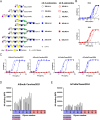This is a preprint.
Bovine H5N1 influenza virus binds poorly to human-type sialic acid receptors
- PMID: 39131285
- PMCID: PMC11312632
- DOI: 10.1101/2024.08.01.606177
Bovine H5N1 influenza virus binds poorly to human-type sialic acid receptors
Update in
-
Bovine H5N1 binds poorly to human-type sialic acid receptors.Nature. 2025 Apr;640(8059):E18-E20. doi: 10.1038/s41586-025-08821-6. Epub 2025 Apr 16. Nature. 2025. PMID: 40240859 No abstract available.
Abstract
Clade 2.3.4.4b highly pathogenic H5N1 avian influenza (HPAI) viruses started circulating widely in lactating dairy cattle in the United States at the end of 2023. Avian influenza viruses enter cells after binding to glycan receptors with terminally linked α2-3 sialic acid, whereas human influenza viruses typically bind to glycan receptors terminally linked α2-6 sialic acid in the upper respiratory tract. Here, we evaluated the receptor binding properties of hemagglutinin (HA) trimers from a clade 2.3.4.4b avian isolate (A/American Wigeon/South Carolina/22-000345-001/2021) and a cattle isolate (A/dairy cattle/Texas/24-008749-002-v/2024). Using two different methods, we found that both of the 2.3.4.4b H5s bound efficiently to glycan receptors with terminally linked α2-3 sialic acid with no detectable binding to glycan receptors with terminally linked α2-6 sialic acid. Our data suggest that clade 2.3.4.4b H5N1 viruses bind poorly to human receptors. It will be important to continue evaluating receptor binding properties of these viruses as they evolve in cattle.
Conflict of interest statement
Conflict of Interest S.E.H reports receiving consulting fees from Sanofi, Pfizer, Lumen, Novavax, and Merck. The authors declare no other competing interests.
Figures

Similar articles
-
Susceptibility of bovine respiratory and mammary epithelial cells to avian and mammalian derived clade 2.3.4.4b H5N1 highly pathogenic avian influenza viruses.bioRxiv [Preprint]. 2025 Jan 9:2025.01.09.632235. doi: 10.1101/2025.01.09.632235. bioRxiv. 2025. PMID: 39829753 Free PMC article. Preprint.
-
Sialic Acid Receptor Specificity in Mammary Gland of Dairy Cattle Infected with Highly Pathogenic Avian Influenza A(H5N1) Virus.Emerg Infect Dis. 2024 Jul;30(7):1361-1373. doi: 10.3201/eid3007.240689. Epub 2024 Jun 11. Emerg Infect Dis. 2024. PMID: 38861554 Free PMC article.
-
A single mutation in dairy cow-associated H5N1 viruses increases receptor binding breadth.Nat Commun. 2024 Dec 30;15(1):10768. doi: 10.1038/s41467-024-54934-3. Nat Commun. 2024. PMID: 39737954 Free PMC article.
-
An Update on Highly Pathogenic Avian Influenza A(H5N1) Virus, Clade 2.3.4.4b.J Infect Dis. 2024 Sep 23;230(3):533-542. doi: 10.1093/infdis/jiae379. J Infect Dis. 2024. PMID: 39283944 Review.
-
Glycans as receptors for influenza pathogenesis.Glycoconj J. 2010 Aug;27(6):561-70. doi: 10.1007/s10719-010-9303-4. Epub 2010 Aug 24. Glycoconj J. 2010. PMID: 20734133 Free PMC article. Review.
Cited by
-
Could H5N1 bird flu virus be the cause of the next human pandemic?Front Microbiol. 2024 Oct 8;15:1477738. doi: 10.3389/fmicb.2024.1477738. eCollection 2024. Front Microbiol. 2024. PMID: 39439938 Free PMC article. No abstract available.
References
-
- Nguyen T. Q., Hutter C., Markin A., Thomas M., Lantz K., Killian M.L., Janzen G.M., Vijendran S., Wagle S., Inderski B., Magstadt D.R., Li G., Diel D.G., Frye E.A., Dmitrov K.M., Swinford A.K., Thompson A.C., Snevik K.R., Suarez D.L., Spackman E., Lakin S.M., Ahola S.C., Johnson K.R., Baker A.L., Robbe-Austerman S., Torchetti M.K., Anderson T.K. Emergence and interstate spread of highly pathogenic avian influenza A(H5N1) in dairy cattle. bioRxiv 10.1101/2024.05.01.591751, (2024). - DOI - PubMed
Publication types
Grants and funding
LinkOut - more resources
Full Text Sources
